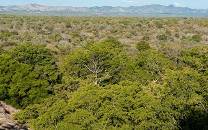Mwabvi Wildlife Reserve was once a stronghold for black rhino, but due to general neglect and heavy poaching, it has fallen off the radar. The reserve is a scenic expanse of rugged bush, with rough 4x4 roads and hiking trails ready to be explored by the more adventurous visitor. Animals that might be encountered include greater kudu, impala, yellow baboon and vervet monkey.

-
Best Time To Go
- May to September (Dry and cool weather)
-
High Season
- July to October (Though the park is never busy)
-
Size
- 340km² / 131mi²
-
Altitude
-
101-339m /331-1,112ft
 View Photos
View Photos
 View Photos
+1
Photos
View Photos
+1
Photos
Pros & Cons
- Adventurous, off-the-beaten-track destination
- Well-priced with ranger available
- Beautiful scenery
- Poaching an ongoing problem
- Limited road network, with 4x4 vehicles essential
- Very little wildlife and animals are skittish
- Only a basic campsite at present
Wildlife
Despite poaching problems, there is still some wildlife in Mwabvi. Leopard, buffalo and possibly lion are still present in the reserve, but animals are skittish and numbers are low. Sightings are hit-and-miss, especially since the road network is very limited. If you spend a couple of days in Mwabvi, you’re likely to see some antelope such as impala, greater kudu and possibly sable. Sightings of vervet monkeys, yellow baboon and warthogs are also likely.
Scenery
Mwabvi covers a stunning tract of untrammeled wilderness. Wooded hills are interrupted by rocky outcrops and little streams in valleys and gorges. The Mwabvi River, after which the park is named, also flows through the reserve.
Activities
Self-guided are permitted in Mwabvi, but the road network is rather limited. These drives are more likely to be rewarding for bird-watchers than for visitors seeking large mammals. Also on offer are , which are the best way to explore this scenic park.
Weather & Climate
The weather and climate of Mwabvi is comparable to that of Malawi in general. See the link below for more information.
Best Time To Visit Mwabvi WR
Mwabvi can be visited throughout the year. The reserve is not a prime wildlife destination and is best explored on foot. The best time for hiking is in the Dry season (May to October), with ideal conditions from May to September. These are also the coolest months. April is a good month for a visit, but the roads might still be bad at the end of the rainy season. From October, the heat and humidity become extreme, although the bush is beautiful and lush.
How To Get to Mwabvi WR
Mwabvi is mostly visited independently. A 4x4 vehicle is required and you need to be totally self-sufficient. The reserve is about 500km/310mi from the capital, Lilongwe, and 150km/90mi from Blantyre. Mwabvi can also be visited from Lengwe National Park. Jambo Africa, which runs the lodge in Lengwe, offers this as an excursion. The drive from Lengwe is around 90km/55mi and takes about 80 minutes*.
*Driving times are only a rough indication. You should always consider the possibility of significant delays.
Health & Safety
Please read our vaccinations and malaria page for Malawi, as well as our general ‘Wildlife Viewing Safety Precautions’ below for more information.

